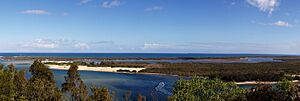Gippsland Lakes facts for kids
The Gippsland Lakes are a group of lakes, marshes, and lagoons in eastern Gippsland, Victoria, Australia. They cover a large area of about 354 square kilometres. The biggest lakes are Lake Wellington, Lake King, and Lake Victoria. Water flows into these lakes from several rivers, including the Avon, Thomson, Latrobe, Mitchell, Nicholson, and Tambo rivers.
Contents
How the Gippsland Lakes Were Formed
The Gippsland Lakes were created in two main ways. First, rivers carried a lot of mud and sand, called silt. This silt built up and formed river deltas. For example, the Mitchell River created long "silt jetties" that stretch for many kilometres into Lake King.
Second, the ocean in Bass Strait helped form the Ninety Mile Beach. This long beach acted like a wall, blocking the rivers from easily reaching the sea.
Before a permanent entrance was made, the water level in the lakes would slowly rise because the rivers were blocked. Eventually, the water would become so high that it would break through the sandy barrier beach. This would let the water level drop back down to sea-level. Over time, the beach would close off the lakes again, and the whole process would repeat. Sometimes it took many years for a new channel to form, and it wasn't always in the same spot.
In 1889, a special wall was built at Lakes Entrance. This wall helped to keep a natural channel open between the lakes and the ocean. This was important because it kept the water level steady. It also created a safe harbour for fishing boats and allowed ships to travel into the lakes. This entrance still needs to be regularly cleaned out (dredged). If it wasn't, the same natural process that formed the lakes would make the entrance too shallow for boats.
In 2011, after some floods, the Gippsland Lakes experienced bioluminescence. This is when living things in the water create light, making the water glow!
Wildlife and Nature in the Lakes
The Gippsland Lakes are home to many different kinds of plants and animals. There are two special protected areas here: The Lakes National Park and Gippsland Lakes Coastal Park. The wetlands of the Gippsland Lakes are also protected by an international agreement called the Ramsar Convention. This agreement helps to protect important wetlands around the world.
About 400 different types of native plants grow here. There are also around 300 different native animal species. Sadly, three types of plants, including two kinds of orchids, are listed as endangered. This means they are at risk of disappearing forever.
Burrunan Dolphins
The lakes are home to about 50 Bottlenose dolphins. These are a special type of dolphin called the Burrunan dolphin (Tursiops australis).
Birds
The wetlands around the lakes provide a home for about 20,000 waterbirds. Some of these birds travel all the way from places like Siberia and Alaska! The lakes are so important for birds that BirdLife International has named them an Important Bird Area (IBA). This is because they regularly support more than 1% of the world's population of Black Swans, Chestnut Teals, and Musk Ducks. Many Fairy Terns also live here.
Exploring the Lakes
The Gippsland Lakes include several different lakes. Here they are, listed from largest to smallest:
- Lake Wellington
- Lake Victoria
- Lake King
- Lake Reeve
- Lake Tyers
- Lake Coleman
Lake Wellington
Lake Wellington is the biggest of the Gippsland Lakes. It covers an area of about 148 square kilometres. It is connected to Lake Victoria by a channel called McLennan Strait.
Lake Victoria
Lake Victoria is the second largest lake. It covers an area of about 78 square kilometres.
Lake King
Lake King covers an area of about 97 square kilometres.
Lake Reeve
Lake Reeve is a very long lake. It has many areas of salty marshes around it.
Lake Tyers
Lake Tyers is not connected to the other Gippsland Lakes. It has its own separate entrance to Bass Strait.
Lake Coleman
The eastern side of Lake Coleman is part of the Lake Coleman Wildlife Reserve. There is also a smaller reserve on the western side called the Lake Coleman West Wildlife Reserve. These reserves cover about 1500 hectares. Most of Lake Coleman is used by the Department of Defence for training exercises.
Images for kids





